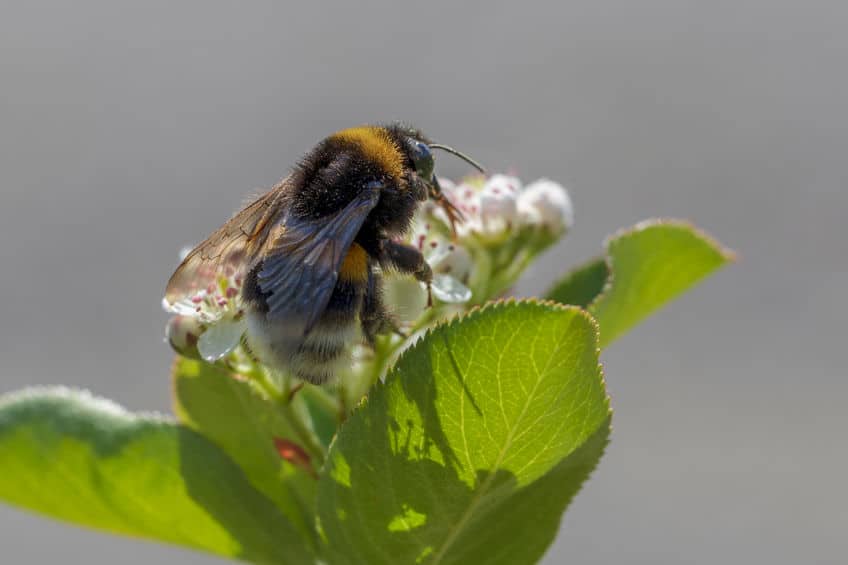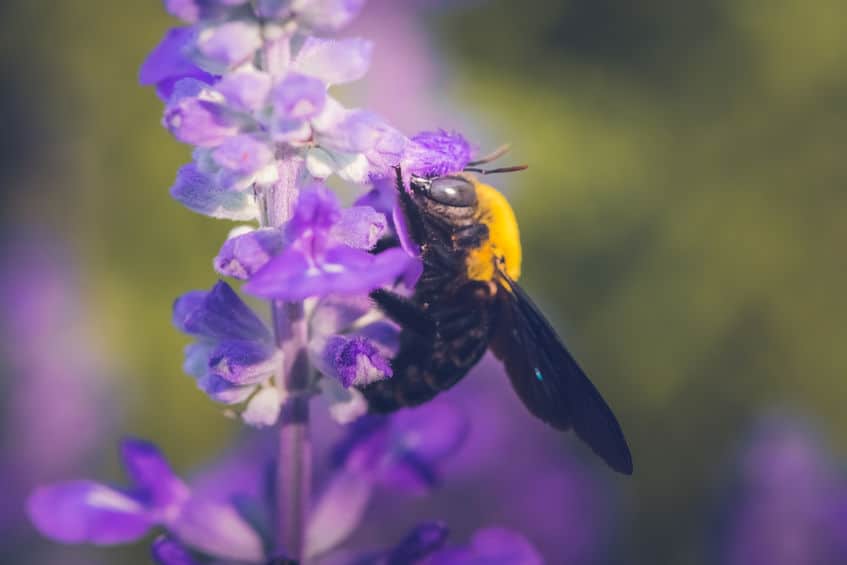Bumblebees, in the Bombus genus, are very well known, and immediately recognized for their large, fuzzy bodies and gentle behavior. They are often seen around plants such as lavender or lilac. However, not all the big fuzzy bees you see buzzing through the yard are bumblebees. Carpenter bees have a similar appearance but are usually deemed a pest by many. They are also in an entirely different genus than the bumblebee; Xylocopa.
Bumblebees are eusocial as they live in colonies with queens. Carpenter bees by contrast are largely solitary with each female laying its own eggs. While bumblebees form nests underground carpenter bees tunnel within wood and as a result are often regarded as a pest. Both are excellent pollinators.
Appearance
A closer look at the two types of bees will reveal more than just a similar size. Both have a large range of species within the genus and will vary on specifics. Bumblebees are usually striped and can have rust-colored, white, or yellow hair alternating with black. Carpenter bees commonly have black abdomens and a yellow thorax, but others are completely black. Xylocopa violacea is a species of carpenter bee that has an entirely black body but stunning blue-purple wings. Some have almost no hair on their abdomen, while others are covered entirely with yellow or orange hair. Bumblebee species are typically all thick with hair, with only a few species having bare abdomens.

Sociality
Bumblebees are true eusocial bees, similar to that of honey bees. They have a queen that lays all the eggs, drones for the queen to mate with, and female workers to forage and care for the brood. Carpenter bees differ in that all the females are fertile and will lay eggs, but some carpenter bee species will live in aggregations for additional protection, making them not quite solitary but not social bees either. The females care for their own eggs and are responsible for foraging on their own, but protection in numbers reduces the likelihood of invaders looking for a meal.

Nesting
Bumblebees live in ground burrows, usually ones that are pre-existing from abandoned nests of other creatures. Their colonies have wax cells formed in large clumps, and the burrow can extend two meters down to the nest. A typical nest will contain a couple of hundred bees, but a strong colony can have up to 1’700 members at its peak.
The carpenter bee gets its name from its wood-nesting habit. The female bees use their strong mandibles to carve their way through dead wood, making tunnels for their brood and food storage. She won’t eat the wood; she’ll just chew it up and spit it out the entrance of the tunnel, leaving behind a small pile of sawdust.
This is where the carpenter bee can be considered a pest—since these tunnels can be several meters in length with many branching chambers, the structural integrity of the wood can be compromised. This wouldn’t be an issue in a fallen log, for instance, but buildings with wooden beams can be potential nesting spots. Luckily, an easy solution exists: carpenter bees don’t like to burrow in treated or painted wood. Provided that the exposed wood has something to seal it over, the carpenter bees will stay away.
Life Cycle
The newly hatched queen bee will mate in the fall and then hibernate the whole winter, while the old queen, her drones, and her workers will all die. The young queen will emerge in spring and immediately begin building a nest and foraging; she needs the protein from plant pollen to lay eggs. As the workers hatch, they will take over the foraging duties and the queen can focus on building up the nest population. When autumn rolls around again, she will lay the egg for the next queen to begin the cycle over again.
An unusual difference in carpenter bees is that in most bee species, the males die before winter. For the most part, drones’ only purpose is for mating, and occasionally for guarding the outside of the nest. Usually, the males will sleep outside of the nest in groups to keep warm at night, but many carpenter drones will actually hibernate throughout the winter alongside the females. Nesting behaviors differ between carpenter species, but many of them will begin their lifecycle in the summer. The bees hatch and occupy the nesting site they are in, or seek out another old burrow. They will forage and consume enough pollen and nectar to allow them to hibernate throughout the winter. In spring, the bees will mate and the females will proceed to add on to the nest, forage, and lay eggs.
Defense
Bees are often known for the fact that they can only sting once, but this rule actually doesn’t apply to most bee species. The honey bee has a barbed stinger, but bumble and carpenter bees have smooth stingers, allowing them to sting multiple times. The bees typically only sting when their nest is threatened, and they tend to give warning beforehand; drones guard the outside and will fly in the face of intruders. Drones don’t have stingers and can’t harm you, but if they are unable to scare off an unwanted guest, the females will step in and introduce you to the business end of their stinger. Bumblebees are known for being docile, and their sting is said to hurt less than that of a honey bee, while carpenter bee stings are said to be on par with their honey-producing cousins. Unless the victim has allergies to bee venom, stings are painful but not dangerous.
Pollination
A characteristic that the bumble and carpenter bee species share is the unique way in which they pollinate. Using their strong legs, the bees will latch on to a flower and emit a high frequency that vibrates the pollen grains and dislodges them from the flower’s anthers. Known as “buzz pollination”, some plants such as tomatoes can only be pollinated by bees that perform this mechanism; honey bees would be of no use in a greenhouse full of tomato plants!
The hairy bodies of both types of bees make them efficient at catching and spreading pollen from plant to plant, but the bumblebee has an additional feature. Like the honey bee, a worker might have to travel far to find pollen, and the flight back home can cause a large loss of pollen grains. Pollen baskets are “pouches” on the back legs that a few species of bees have. The bees mix pollen with saliva or nectar and tightly pack them into a pellet that sits securely on their legs. This allows them to gather more food within a single trip and stay out longer, rather than flying back and forth between the hive.
Carpenter bees, like many non-social bees, forage closer to home. Solitary bee species often can’t afford to fly too far from their nest, as leaving it unprotected for too long can invite predators. As well, their bodies only hold so much pollen, and much of it can be lost on the return trip if traveling too far.
Both carpenter bees and bumblebees are phenomenal pollinators and are important aspects of the environment. Carpenter bee species alone account for 10% of all crop pollination, and the two genus’ of bees and their unique “buzz pollination” make them valuable for plants that cannot be pollinated by other insects. Allowing room for these bees to inhabit and live in the area won’t provide any honey, but they will pollinate with great efficiency and improve the overall environment. Leave old burrows for bumblebees to live in, and allow fallen logs and woodpiles to become homes for carpenter bees; your garden will thank you.
